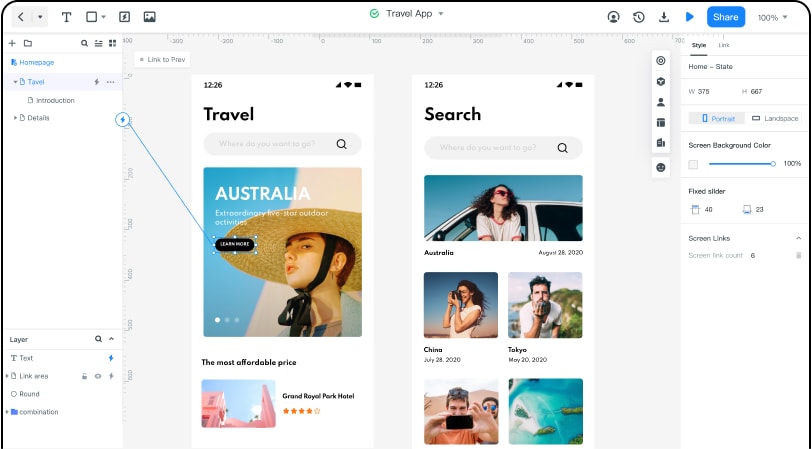Beyond the Hype: What Figma's IPO Really Reveals About Our Design Tools
I still remember the days when design happened in isolation—saving .PSD files locally, emailing them to teammates, and hoping everyone was looking at the latest version. Then came Figma, and everything changed. By moving design into the browser, it opened the doors to real-time collaboration. When Figma went public in 2025, it wasn't just a corporate milestone—it felt like a collective win for the entire design community.
But while many saw the IPO as an endpoint, it's clearer now that it was really a beginning. The conversation around how we design together is just getting started.
- More Than a Valuation
- Growth and Its Challenges
- Three Trends Shaping the Next Wave
- From Tool Loyalty to Tool Strategy
- Embracing a Multi-Tool Workflow
- Where Mockitt Adds Value
- Looking Forward
More Than a Valuation
The headlines naturally focused on the numbers, but the real significance of Figma's journey lies in how it reflects the evolving stature of design itself. Not long ago, designers were often brought in late in the process—asked to “make things look good” before launch. Today, design is increasingly viewed as foundational to product strategy from the very first sketch.
This evolution has reshaped team structures. Silos between design, engineering, and product management are softening. In their place, tools that support real-time collaboration have shifted from optional to essential.
Growth and Its Challenges
There's no doubt that becoming a public company brings advantages. Greater resources often lead to accelerated innovation, richer integrations, and stronger customer support—all of which benefit users.
At the same time, scaling a platform often means serving a broader range of users, from individual freelancers to global enterprises. This is a natural part of a product's evolution—one we've seen across the software industry. As tools mature, they often expand their capabilities to meet diverse and growing needs.
This expansion, in turn, creates opportunities for more focused tools that address specific workflows or user segments.
Three Trends Shaping the Next Wave
Looking across the design tool landscape, a few patterns stand out:
First, the cloud is no longer optional—it's the default. The era of sending static files is over. Teams now expect to collaborate in real time, with seamless synchronization across contributors.
Second, automation is rising. From responsive layout suggestions to reusable component libraries, AI-assisted features are handling repetitive work, freeing designers to focus on higher-level creative challenges.
And third—perhaps most importantly—we're recognizing that no single tool can perfectly serve every team. The needs of an in-house design team at a large tech company differ from those of a solopreneur testing a new idea or a product manager mapping a user journey.
From Tool Loyalty to Tool Strategy
The most effective teams we work with have moved beyond seeking a single “best” tool. Instead, they're asking a more practical question: “What's the right tool for this task?”
Larger organizations often benefit from the depth and integration of established platforms like Figma. Smaller teams and freelancers, on the other hand, may prioritize ease of use, speed, and affordability.
Embracing a Multi-Tool Workflow
Increasingly, teams are adopting what might be called a “toolkit mindset”—curating a set of specialized tools for different phases of the design process.
They might rely on Figma for developer handoffs and design system management, while turning to other platforms for brainstorming, wireframing, or rapid prototyping.
This approach offers clear benefits:
Tools can be matched to specific tasks and workflows
Teams can experiment without overhauling their entire setup
Specialized tools often deliver better results for focused use cases
Where Mockitt Adds Value
This is where tools like Mockitt enter the picture. In a space where many platforms are expanding their scope, Mockitt has found resonance by focusing on a clear goal: helping teams move quickly from idea to interactive prototype.

Rather than positioning as a direct competitor to comprehensive platforms, Mockitt serves as a complementary solution—especially useful in early ideation, user flow mapping, and lightweight collaboration.
For smaller teams, freelancers, and cross-functional contributors, this focus on immediacy and ease of use can be particularly valuable. By reducing the learning curve, Mockitt helps users spend less time configuring tools and more time bringing ideas to life.
Looking Forward
Figma's IPO was a meaningful moment—one that underscored the central role design now plays in how digital products are built.
But the evolution of design tools is far from over.
What comes next won't be about crowning a new "winner". It'll be about building adaptable toolkits that reflect the real-world ways teams work. We're already seeing this shift, as new tools emerge to solve specific challenges with clarity and focus.
This isn't a sign of a fragmented market—it's a sign of a maturing one. After years of adapting our workflows to one-size-fits-all solutions, we're now entering an era where tools are being shaped by the diverse, dynamic ways we actually create.
